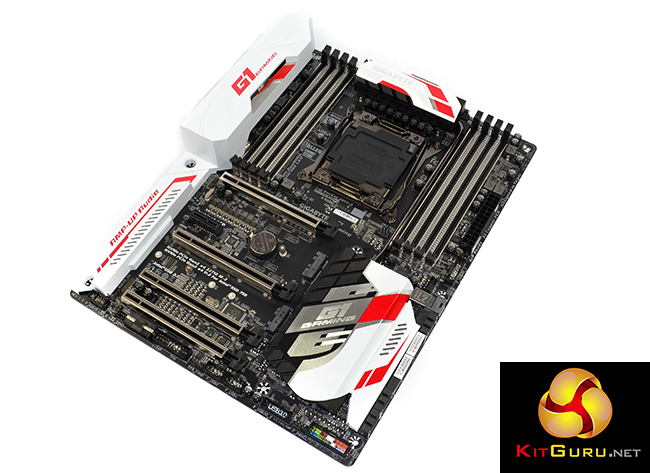Strong performance, an effective power delivery system and smart design choices are three fundamental characteristics of Gigabyte's X99-Ultra Gaming.
Stock-clocked performance was competitive against a pair of Asus alternatives. Gigabyte's efficient International Rectifiers-based power delivery system scored the X99-Ultra Gaming a win in terms of power consumption, but Asus' flagship Rampage V Edition 10 was marginally faster in memory-related tasks.
Overclocking performance was solid, provided the BIOS profile one uses is free of bugs. We pushed the 6950X to its 4.3GHz limit while also boosting the CPU Cache (Ring) to 3.4GHz and using 3.2GHz DDR4. Unfortunately, we went through numerous flaky BIOS profiles before finally garnering full stability with the motherboard using the F4 BIOS revision.
One dodgy BIOS revision is forgiveable. Two or more is unacceptable and can really put doubt in the mind of a user who wants to upgrade their BIOS for new features, but doesn't want to risk introducing instability. Oh, and don't think that troubleshooting a bug-ridden BIOS is simple – it isn't thanks to the lack of onboard buttons and no debug LED display.
Design and layout are areas where Gigabyte's engineers deserve credit. The ability to operate four high-bandwidth (PCIe 3.0 x8) expansion cards in addition to 32Gbps U.2 and M.2 SSDs is superb. And smart slot spacing means that three of those high-bandwidth devices can be beefy graphics cards. The only disappointing design move is the omission of U.2 capability when using a 28-lane CPU. Intel's DSL6540-based unconstrained USB 3.1 ports are a welcomed inclusion over the inferior ASMedia offerings.
Gigabyte sprinkles RGB LEDs around the board in areas where users are likely to want them. The LEDs are colour-accurate, not overpowering, and able to operate in a number of static or pulse modes. There's also a 4-pin header for managing external RGB LED strips. I am, however, disappointed that Gigabyte hasn't split the LED system into distinct motherboard areas. It would be nice to have the DIMM slots glowing blue while the PCIe slots are lit red, if a user desired. But that's not possible, despite the proficiency of Gigabyte's well-built UEFI-based lighting tool.
The X99-Ultra is one of Gigabyte's first motherboards to be equipped with the company's new UEFI design. Enhanced ease-of-use and a significantly improved layout are positives for the new interface. While it's not quite as kind on the eye as some competing vendors' interfaces, functionality of Gigabyte's offering is a positive, especially when focussing on the excellent fan control options. A few polishing touches and Gigabyte can confidently say that it has a UEFI with positive points over each of the competing vendors' (albeit with some weaknesses too).
At this price point, 802.11ac WiFi seems to be commonplace amongst the X99-Ultra Gaming's competitors. To some, its omission may be an annoyance, but to others it will be a welcomed cost reduction. Either way, Gigabyte has provisioned the M.2 PCIe slot and rear IO connectors to accept a WiFi adapter, so it's a simple drop-in upgrade. Continuing with networking, Killer and Intel NICs give a user choice and redundancy at the expense of increased cost.
Priced just under £250 at Overclockers UK, the Gigabyte X99-Ultra Gaming manages to undercut its primary competitors – MSI's X99A Gaming Pro Carbon and Asus' Strix X99 Gaming – by around 10%. While 10% is typically a noteworthy amount, in a marketplace where the cheapest CPU is pushing £400 and a go-to set of memory is almost £100, £25 less for a motherboard is not a significant saving, but it's still a saving nonetheless.
Against its closest MSI and Asus competitors, Gigabyte has areas where the X99-Ultra Gaming shines – Intel USB 3.1, superb fan control, and Intel plus Killer NICs, for example. But there are also areas where the competition is strong, such as onboard buttons, segregated LED lighting sections, more mature UEFIs, and WiFi (on Asus' board). Gigabyte's free USB 3.1 front panel bay can be added into the value equation, but only until the offer ends on September 30th 2016.
Whether Gigabyte's X99-Ultra Gaming is a more suitable candidate than its closely-priced Asus and MSI competitors is a tough question to answer and depends heavily upon your usage requirements. The Gigabyte offering is, without question, an excellent piece of hardware for its fair asking price, but tough competition from Asus and MSI prevent it from being the outright go-to RGB motherboard in this market section. Ultimately, the Gigabyte X99-Ultra Gaming is a worthy purchase that will happily light up your gaming system in more than one way.
Discuss on our Facebook page, over HERE.
Pros:
- Eye-catching RGB LED system with very good UEFI-based control.
- Excellent fan control system in the UEFI and OS software.
- A good introduction of the new UEFI which is feature-rich, even if it is a little rough around the edges.
- Supports four PCIe 3.0 x8 expansion cards in addition to 32Gbps U.2 and M.2, simultaneously (using a 40-lane CPU).
- 20Gbps-capable Intel DSL6540 USB 3.1 ports.
- Strong power delivery system which provided good voltage accuracy when overclocking and low power consumption.
- Smart design and layout decisions for expansion slots, connectors, and PCIe lanes.
Cons:
- No onboard power, reset, or clear CMOS buttons, in addition to a debug LED.
- U.2 connector being disabled with a 28-lane CPU is disappointing.
- Numerous instability issues with older BIOSes, both in beta and full release form.
- Segregated RGB lighting zones would be a worthwhile improvement.
KitGuru says: RGB LEDs, Intel USB 3.1, and superb expansion capabilities make the Gigabyte X99-Ultra Gaming an alluring motherboard which is priced fairly.
 KitGuru KitGuru.net – Tech News | Hardware News | Hardware Reviews | IOS | Mobile | Gaming | Graphics Cards
KitGuru KitGuru.net – Tech News | Hardware News | Hardware Reviews | IOS | Mobile | Gaming | Graphics Cards






Voltage accuracy is the X99A Gaming Pro Carbon’s weakest link, It had never given what I asked. For example, I asked 1.197 volts, it gave 1.194 volts, and CUP-Z read 1.194 volts. And when I asked 1.199 volts, it gave 1.192 volts, CPU-Z read 1.199 volts, but more stable. I think CPU-Z is the correct one.
So … This motherboard with the Intel 6850k and a STRIX GTX1080 has disabled U.2 AND M.2 ??? Holly …